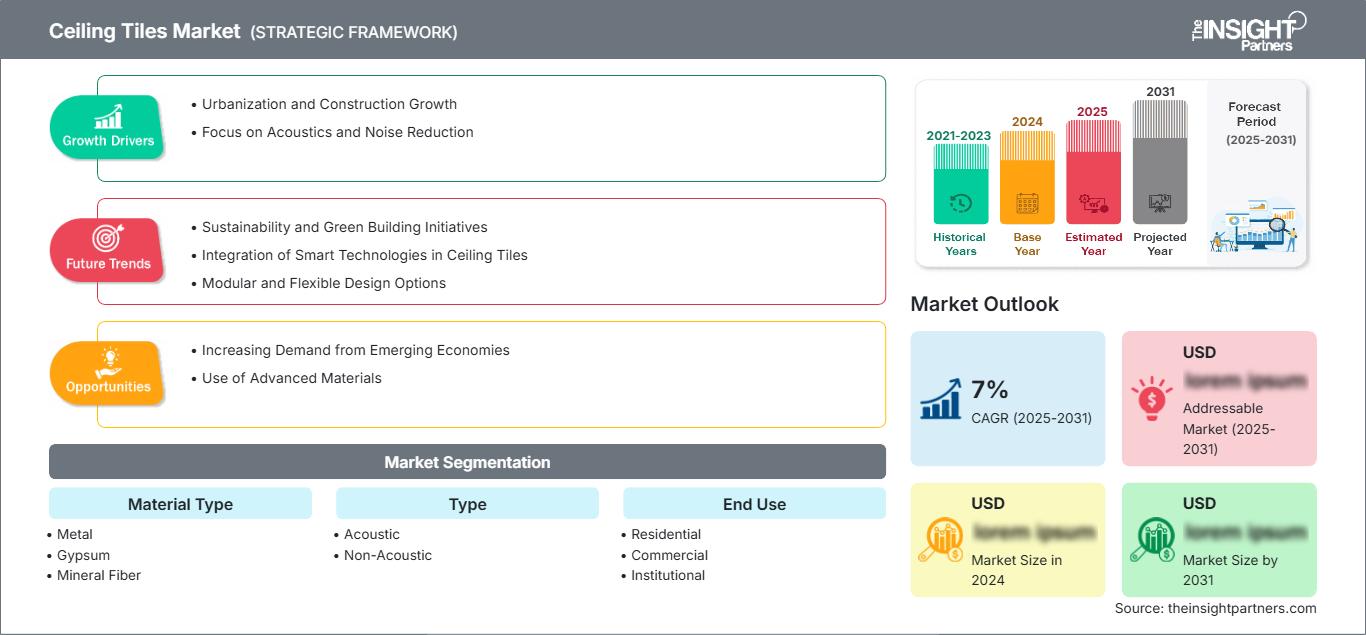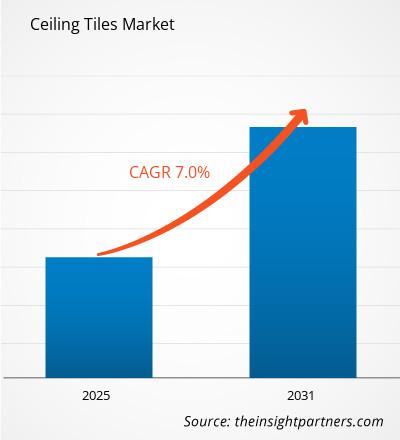Der Markt für Deckenplatten wird bis 2031 voraussichtlich ein Volumen von 14,59 Milliarden US-Dollar erreichen. Für den Zeitraum 2025–2031 wird ein jährliches Wachstum von 9,4 % erwartet.
Der Markt für Deckenplatten ist nach Materialart, Typ und Endverwendung segmentiert. Nach Materialart wird der Markt in Metallgips, Mineralfaser und Sonstige unterteilt. Nach Typ wird der Markt in akustische und nicht-akustische Deckenplatten segmentiert. Nach Endverwendung wird der Markt in Wohn-, Gewerbe- und institutionelle Bereiche unterteilt. Der Bericht „Markt für Deckenplatten“ von The Insight Partners beschreibt die aktuelle Marktlage und das zukünftige Wachstum sowie die wichtigsten Wachstumstreiber, Herausforderungen und Chancen. Dies wird verschiedenen Akteuren im Geschäftsbereich Einblicke ermöglichen, wie beispielsweise:
- Technologieanbieter/Hersteller: Um die sich entwickelnde Marktdynamik zu verstehen und potenzielle Wachstumschancen zu erkennen, können sie fundierte strategische Entscheidungen treffen.
- Investoren: Um eine umfassende Trendanalyse hinsichtlich Marktwachstumsrate, Finanzprognosen und Chancen entlang der Wertschöpfungskette durchzuführen.
- Regulierungsbehörden: Um Richtlinien zu regulieren und Aktivitäten auf dem Markt zu überwachen, mit dem Ziel, Missbrauch zu minimieren, das Vertrauen der Anleger zu wahren und die Integrität und Stabilität des Marktes zu gewährleisten. Marktsegmentierung für Deckenfliesen: Materialart
- Metall
- Gips
- Mineralfaser
Typ
- Akustisch
- Nicht-akustisch
Endverwendung
- Wohnbereich
- Gewerbebereich
- Institutionell
Geografie
- Nordamerika
- Europa
- Asien-Pazifik
- Süd- und Mittelamerika
- Naher Osten und Afrika
Passen Sie diesen Bericht Ihren Anforderungen anSie erhalten kostenlos Anpassungen an jedem Bericht, einschließlich Teilen dieses Berichts oder einer Analyse auf Länderebene, eines Excel-Datenpakets sowie tolle Angebote und Rabatte für Start-ups und Universitäten.
Markt für Deckenplatten: Strategische Einblicke

-
Holen Sie sich die wichtigsten Markttrends aus diesem Bericht.Dieses KOSTENLOSE Beispiel umfasst Datenanalysen, die von Markttrends bis hin zu Schätzungen und Prognosen reichen.
Wachstumstreiber des Marktes für Deckenplatten
- Urbanisierung und Bauboom: Die rasante Urbanisierung, insbesondere in Entwicklungsländern, führt zu einer enormen Nachfrage nach Gewerbe- und Wohngebäuden. Der daraus resultierende Anstieg des Bautempos beeinflusst wiederum den Markt für Deckenplatten, da diese einen wesentlichen Bestandteil moderner Innenausbauten darstellen.
- Fokus auf Akustik und Lärmschutz: Das gestiegene Bewusstsein für die Auswirkungen von Lärmbelästigung auf die menschliche Gesundheit und Produktivität erfordert einen zunehmenden Fokus auf das Akustikmanagement von Gebäuden. Deckenplatten sind in der Tat eine der wichtigsten Komponenten zur Schallabsorption und Lärmreduzierung in Gebäuden und spielen daher eine entscheidende Rolle bei architektonischen Gestaltungsentscheidungen für Büros, Schulen, Gesundheitseinrichtungen und Wohngebäude.
Zukünftige Trends des Marktes für Deckenplatten
- Nachhaltigkeit und Initiativen für umweltfreundliches Bauen: Ein aktueller Trend ist die Nachfrage nach nachhaltigen Baupraktiken und Zertifizierungen für umweltfreundliches Bauen. Da diese Entwicklung weiterhin große Aufmerksamkeit erregt, steigt die Nachfrage nach Deckenplatten aus recycelten oder erneuerbaren Materialien, Produkten zur Förderung gesunder Raumluftqualität und energieeffizienten Räumen.
- Integration intelligenter Technologien in Deckenplatten: Angesichts des wachsenden Interesses der Verbraucher an intelligenten Technologien werden Deckenplatten heute so gestaltet, dass sie in der veränderten Raumlandschaft mehr Funktionen erfüllen. Viele Hersteller haben Deckenplatten entwickelt, die mit Sensoren zur Lichtsteuerung, Temperatur- oder Anwesenheitserkennung kompatibel sind. Diese intelligenten Deckensysteme können somit zur Energieeinsparung und einem besseren Gebäudemanagement beitragen.
- Modulare und flexible Designoptionen: Neben agilen Arbeitsbereichen, die aufgrund des Bedarfs an räumlicher Anpassungsfähigkeit gefragt sind, gewinnen modulare Deckenlösungen zunehmend an Bedeutung. Da Deckenplattensysteme einfach zu installieren und selbstständig umzubauen sind, erfreuen sie sich großer Beliebtheit, da sie schnelle Änderungen der Raumaufteilung oder Akustik ermöglichen.
Marktchancen für Deckenplatten
- Steigende Nachfrage aus Schwellenländern: Die rasante Urbanisierung und der Infrastrukturausbau steigern die Nachfrage nach Deckenplatten in Schwellenländern erheblich. In den Ländern dieses Blocks, die sich in einem starken Wirtschaftswachstum befinden, nimmt der Bau von Wohnungen, Gewerbe- und Industriegebäuden rasant zu. Die daraus resultierenden höheren verfügbaren Einkommen, kombiniert mit dem wachsenden Wunsch nach einem veränderten Lebensstil und mehr Wert auf Ästhetik und Funktionalität in der Raumgestaltung, erweitern das Absatzpotenzial. Durch staatliche Investitionen in öffentliche Infrastrukturprojekte steigt die Nachfrage nach robusteren und kostengünstigeren Deckenlösungen zusätzlich. Hersteller können diesen Trend nutzen, indem sie neue, nachhaltige Produkte entwickeln, die den Bedürfnissen dieser aufstrebenden Märkte gerecht werden. Einsatz fortschrittlicher Materialien: Neue Materialien oder Verbundwerkstoffe für Deckenplatten mit potenziell verbesserter Leistung könnten bedeutende Chancen eröffnen. Materialien mit hervorragenden akustischen Eigenschaften bei gleichzeitig extrem geringem Gewicht könnten den Markt revolutionieren. Phasenwechselmaterialien oder andere intelligente Materialien könnten potenziell zu Deckenplatten führen, die aktiv zur Temperaturregulierung in Gebäuden beitragen.
Markt für Deckenfliesen
Die regionalen Trends und Einflussfaktoren auf den Markt für Deckenplatten im gesamten Prognosezeitraum wurden von den Analysten von The Insight Partners ausführlich erläutert. Dieser Abschnitt behandelt außerdem die Marktsegmente und die geografische Verteilung des Marktes für das Management von Herzrhythmusstörungen in Nordamerika, Europa, dem asiatisch-pazifischen Raum, dem Nahen Osten und Afrika sowie Süd- und Mittelamerika.
Umfang des Marktberichts zu Deckenfliesen
By Typ- akustisch
- nicht akustisch
- Wohn-
- Gewerbe-
- institutionelle Nutzung
- Nordamerika
- Europa
- Asien-Pazifik
- Süd- und Mittelamerika
- Naher Osten und Afrika
- Großbritannien
- Deutschland
- Frankreich
- Russland
- Italien
- Restliches Europa
- China
- Indien
- Japan
- Australien
- Restlicher Asien-Pazifik
- Brasilien
- Argentinien
- Restliches Süd- und Mittelamerika
- Südafrika
- Saudi-Arabien
- Vereinigte Arabische Emirate
- Restlicher Naher Osten und Afrika
Berichtsattribut Einzelheiten Marktgröße in 2024 US$ XX Billion Marktgröße nach 2031 US$ 14.59 Billion Globale CAGR (2025 - 2031) 9.4% Historische Daten 2021-2023 Prognosezeitraum 2025-2031 Abgedeckte Segmente By Materialtyp - Metall
- Gips
- Mineralfaser
Abgedeckte Regionen und Länder Nordamerika - USA
- Kanada
- Mexiko
Marktführer und wichtige Unternehmensprofile - Saint-Gobain
- SAS International
- Armstrong World Industries, Inc.
- Byucksan Corporation
- CertainTeed
- CSR Limited
- Hunter Douglas Inc.
- Knauf Group
- USG Corporation
Marktdichte der Akteure im Bereich Deckenfliesen: Auswirkungen auf die Geschäftsdynamik
Der Markt für Deckenplatten wächst rasant, angetrieben durch die steigende Nachfrage der Endverbraucher. Gründe hierfür sind unter anderem sich wandelnde Verbraucherpräferenzen, technologische Fortschritte und ein wachsendes Bewusstsein für die Vorteile des Produkts. Mit steigender Nachfrage erweitern Unternehmen ihr Angebot, entwickeln innovative Lösungen, um den Kundenbedürfnissen gerecht zu werden, und nutzen neue Trends, was das Marktwachstum zusätzlich beflügelt.

- Holen Sie sich die Markt für Deckenplatten Übersicht der wichtigsten Akteure
Wichtigste Verkaufsargumente
- Umfassende Abdeckung: Der Bericht bietet eine umfassende Analyse der Produkte, Dienstleistungen, Typen und Endnutzer des Marktes für Deckenplatten und vermittelt so ein ganzheitliches Bild.
- Expertenanalyse: Der Bericht basiert auf dem fundierten Wissen von Branchenexperten und Analysten.
- Aktuelle Informationen: Der Bericht gewährleistet Geschäftsrelevanz durch die Berücksichtigung aktueller Informationen und Datentrends.
- Anpassungsmöglichkeiten: Dieser Bericht kann an spezifische Kundenanforderungen angepasst werden und sich optimal in die Geschäftsstrategien integrieren.
Der Forschungsbericht zum Markt für Deckenplatten kann somit maßgeblich dazu beitragen, das Branchenszenario und die Wachstumsaussichten zu entschlüsseln und zu verstehen. Auch wenn einige berechtigte Bedenken bestehen, überwiegen die Vorteile dieses Berichts insgesamt die Nachteile.
- Historische Analyse (2 Jahre), Basisjahr, Prognose (7 Jahre) mit CAGR
- PEST- und SWOT-Analyse
- Marktgröße Wert/Volumen – Global, Regional, Land
- Branchen- und Wettbewerbslandschaft
- Excel-Datensatz
Aktuelle Berichte
Erfahrungsberichte
Grund zum Kauf
- Fundierte Entscheidungsfindung
- Marktdynamik verstehen
- Wettbewerbsanalyse
- Kundeneinblicke
- Marktprognosen
- Risikominimierung
- Strategische Planung
- Investitionsbegründung
- Identifizierung neuer Märkte
- Verbesserung von Marketingstrategien
- Steigerung der Betriebseffizienz
- Anpassung an regulatorische Trends






















 Kostenlose Probe anfordern für - Markt für Deckenplatten
Kostenlose Probe anfordern für - Markt für Deckenplatten